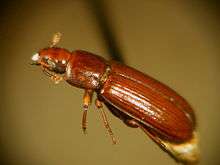Flour beetle
| Flour beetles | |
|---|---|
 | |
| Tribolium castaneum | |
| Scientific classification | |
| Domain: | Eukaryota |
| Kingdom: | Animalia |
| Phylum: | Arthropoda |
| Subphylum: | Hexapoda |
| Class: | Insecta |
| Order: | Coleoptera |
| Family: | Tenebrionidae (partim) |
| Genera | |
|
Tenebrio | |
Flour beetles are members of the darkling beetle genera Tribolium or Tenebrio. They are pests of cereal silos and are widely used as laboratory animals, as they are easy to keep. The flour beetles consume wheat and other grains, are adapted to survive in very dry environments, and can withstand even higher amounts of radiation than cockroaches.[1] They are a major pest in the agricultural industry and are highly resistant to insecticides.
The larvae of T. molitor, when full-grown, are known as mealworms; small specimens and the larvae of the other species are called mini mealworms.
Selected species
- Tribolium castaneum – red flour beetle
- Tribolium confusum – confused flour beetle
- Tribolium destructor – destructive flour beetle
- Tenebrio molitor – mealworm beetle
- Tenebrio obscurus – mini mealworm
Research
In 2008, the Tribolium castaneum genome was sequenced by the Tribolium Genome Sequencing Consortium.[2]
External links
References
This article is issued from Wikipedia - version of the 2/19/2016. The text is available under the Creative Commons Attribution/Share Alike but additional terms may apply for the media files.